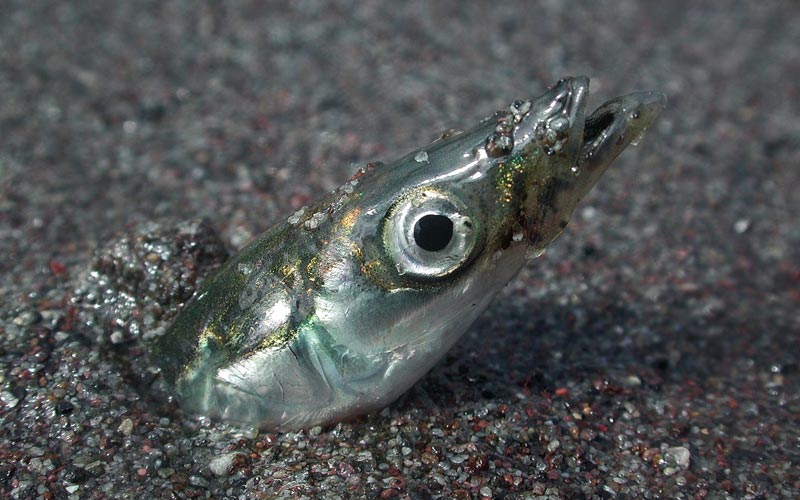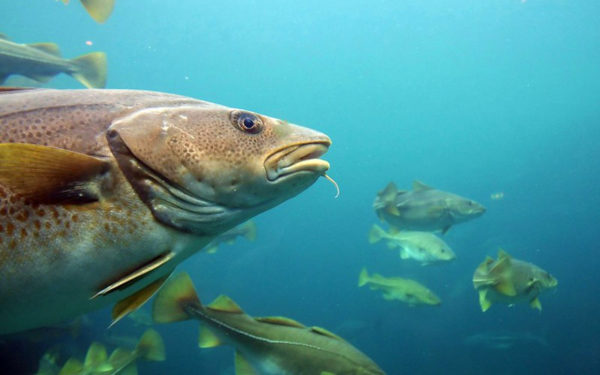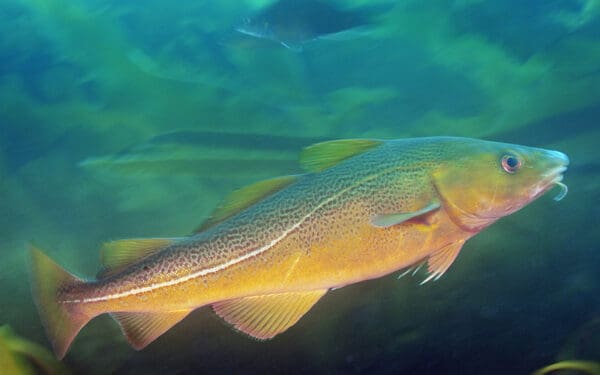
Researcher discusses how a decline of sand lances and other forage fish could change the future of larger species, coastal communities, and the ocean food web. Photo: Mandy Lindeberg, NOAA/NMFS/AKFSC
Off the coast of New England, in the Stellwagen Bank National Marine Sanctuary, lives a small and wiggly forage fish – called the sand lance – that hides under the sand below the surf.
While its name may not resonate with most people, sand lances play a crucial role in the ocean food web. That’s why this little fish (4 to 8 inches) has caught the attention of marine scientists.
We sat down with Justin Suca, a researcher and graduate student at the Llopiz lab at the Woods Hole Oceanographic Institution (WHOI), to learn more about sand lances and the many species that rely on them. Justin’s work – in collaboration with scientists at Stellwagen Bank National Marine Sanctuary, the Northeast Fisheries Science Center, University of Rhode Island, Boston University, and the University of Connecticut – highlights the vital role of sand lances and other forage fish species for coastal communities, the fishing industry, and the entire ocean ecosystem. Every link in the food chain matters and it’s more important than ever to support efforts protecting even the smallest ones.
The following interview has been edited for clarity.
What sparked your interest in learning about sand lances?
The northern sand lance is a little-known species, but they have a very important role in the ecosystem. From humpback whales to puffins, and important commercial fish like the Atlantic cod, many species that we know depend on them for food. So, understanding the life cycle of this species can teach us a lot about other species that prey on them.
What have you learned about this species through your research?
Our research has shown that northern sand lances rely on a species of plankton called Calanus finmarchicus – the same species that right whales depend on. And we learned that the abundance of Calanus affects the ability of the sand lance to reproduce.
What’s more, existing research shows a correlation between climate change and the availability of this type of plankton. More specifically, the scientific community believes that the availability of Calanus is going to decrease with time in the Gulf of Maine – in part due to the increasing influence of the Gulf Stream, a warm ocean current bringing heat from the tropics toward the North Atlantic.
Calanus finmarchicus is a cold-water species. So, the hotter temperatures in the Gulf of Maine could result in potentially less food for sand lance – ultimately leading to a decline in the population of this forage fish.
Sand lances themselves are also sensitive to rising water temperatures. Our work suggests that warmer winters make it hard for older sand lances to survive. Younger fish may have better chances of surviving under these conditions. But these smaller fish may not reproduce abundantly enough to sustain their population and provide food to predators.
If this pattern continues, the future of sand lances [and the species that feed on these forage fish] could be pretty grim.
What can your research tell us about the species that interact with sand lances?
Sand lances are rich in fat and other lipids. That’s why they are so important for the ocean food web. Just to name a few species that prey on them: commercial fish like Atlantic cod, mammals like humpback whales and seals, and even seabirds like terns, puffins, and shearwaters.
A decline in sand lance could impact the diets, migration patterns, and distribution of these species. Previous work, for example, shows that their availability can shift the distribution of species like Atlantic cod.
What does a day in the field look like?
It changes day by day. Some parts can be pretty fun – like going on a boat to Stellwagen Bank to collect information about the water conditions, Calanus, and sand lance. Each trip, we catch specimens and take them to the lab to dissect them. We study their health and basic biology to better understand their life cycle.
A fortunate part about studying forage fish is that we get to see a lot of predators like humpback whales, seabirds, seals, etc. And, from a safe and legal distance, we have even seen some right whales while doing our fieldwork.
What do you want people to understand about your work?
If things don’t change, the future of the New England shelf as we know it could look very different.
The decline of sand lance could change the seascape. Charismatic seabirds – like puffins and roseate terns – that we love, whale watching tourism, and local fishing industries are all connected to this little fish and could be impacted by changes in its population.
Learning about what causes shifts in sand lances distribution and their ability to reproduce is a first step toward making the changes needed to protect the future of this species as well as the industries and communities that would be impacted by its decline. But, overall, this research shows we need to focus on protecting the full forage fish community. So that if a species of forage fish declines from overfishing or climate change, other species will be abundant enough to maintain enough food for predators.
Switching topics a bit, how has your understanding of science as a field changed during your time at WHOI?
Geosciences and oceanography as a whole have lacked in many aspects of equity, diversity, and inclusion. That’s why a group of people at WHOI and other institutions started a program called URGE (Unlearning Racism in Geoscience), where facilitators put forward a curriculum every other week for scientists within geoscience. The workshops help students learn and think about different ways that racism plays into the history of science and how it continues to be perpetuated today in practices such as hiring processes, lab policies, and networking.
One of the things that we have been working on is how to slowly disassemble the very Eurocentric view of science that we have all been abiding by for so long. To me, that means thinking about how to involve more people from the community and move away from doing science in an extractive manner – it means developing respect and understanding for different ways of knowing.
Our views can limit what we can do and achieve in science. If science is always done by and for privileged people, only a few interests will be supported, and that doesn’t benefit the world at large.
Learn more about Justin’s research with forage fish and other important species.



